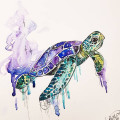tørtlē
I am the turtle,
able to live simply anywhere,
even underwater for short periods,
with my home on my back.

Turtles are the only reptiles that migrate long distances, more specifically the marine species that can travel up to thousands of kilometers. Some non-marine turtles, such as the species of Geochelone (terrestrial), Chelydra (freshwater), and Malaclemys (estuarine), migrate seasonally over much shorter distances, up to around 27 km (17 mi), to lay eggs. Such short migrations are comparable to those of some lizards, snakes, and crocodilians. Sea turtles nest in a specific area, such as a beach, leaving the eggs to hatch unattended. The young turtles leave that area, migrating long distances in the years or decades in which they grow to maturity, and then return seemingly to the same area every few years to mate and lay eggs.
█
Turtles are an order of reptiles known as Testudines, characterized by a special shell developed mainly from their ribs. Modern turtles are divided into two major groups, the Pleurodira (side necked turtles) and Cryptodira (hidden necked turtles), which differ in the way the head retracts. There are 360 living and recently extinct species of turtles, including land-dwelling tortoises and freshwater terrapins. They are found on most continents, some islands and, in the case of sea turtles, much of the ocean. Like other amniotes (reptiles, birds, and mammals) they breathe air and do not lay eggs underwater, although many species live in or around water.
Turtle shells are made mostly of bone; the upper part is the domed carapace, while the underside is the flatter plastron or belly-plate. Its outer surface is covered in scales made of keratin, the material of hair, horns, and claws. The carapace bones develop from ribs that grow sideways and develop into broad flat plates that join up to cover the body. Turtles are ectotherms or "cold-blooded", meaning that their internal temperature varies with their direct environment. They are generally opportunistic omnivores and mainly feed on plants and animals with limited movements. Many turtles migrate short distances seasonally. Sea turtles are the only reptiles that migrate long distances to lay their eggs on a favored beach.
Turtles have appeared in myths and folktales around the world. Some terrestrial and freshwater species are widely kept as pets. Turtles have been hunted for their meat, for use in traditional medicine, and for their shells. Sea turtles are often killed accidentally as bycatch in fishing nets. Turtle habitats around the world are being destroyed. As a result of these pressures, many species are extinct or threatened with extinction.
█
The word turtle is borrowed from the French word tortue or tortre 'turtle, tortoise'. It is a common name and may be used without knowledge of taxonomic distinctions. In North America, it may denote the order as a whole. In Britain, the name is used for sea turtles as opposed to freshwater terrapins and land-dwelling tortoises. In Australia, which lacks true tortoises (family Testudinidae), non-marine turtles were traditionally called tortoises, but more recently turtle has been used for the entire group. The name of the order, Testudines (/tɛˈstjuːdɪniːz/ teh-STEW-din-eez), is based on the Latin word testudo 'tortoise'; and was coined by German naturalist August Batsch in 1788. The order has also been historically known as Chelonii (Latreille 1800) and Chelonia (Ross and Macartney 1802), which are based on the Ancient Greek word χελώνη (chelone) 'tortoise'. Testudines is the official order name due to the principle of priority. The term chelonian is used as a formal name for members of the group.█
Turtles, like other reptiles, have a limited ability to regulate their body temperature. This ability varies between species, and with body size. Small pond turtles regulate their temperature by crawling out of the water and basking in the sun, while small terrestrial turtles move between sunny and shady places to adjust their temperature. Large species, both terrestrial and marine, have sufficient mass to give them substantial thermal inertia, meaning that they heat up or cool down over many hours. The Aldabra giant tortoise weighs up to some 60 kilograms (130 lb) and is able to allow its temperature to rise to some 33 °C (91 °F) on a hot day, and to fall naturally to around 29 °C (84 °F) by night. Some giant tortoises seek out shade to avoid overheating on sunny days. On Grand Terre Island, food is scarce inland, shade is scarce near the coast, and the tortoises compete for space under the few trees on hot days. Large males may push smaller females out of the shade, and some then overheat and die.
Adult sea turtles, too, have large enough bodies that they can to some extent control their temperature. The largest turtle, the leatherback, can swim in the waters off Nova Scotia, which may be as cold as 8 °C (46 °F), while their body temperature has been measured at up to 12 °C (22 °F) warmer than the surrounding water. To help keep their temperature up, they have a system of countercurrent heat exchange in the blood vessels between their body core and the skin of their flippers. The vessels supplying the head are insulated by fat around the neck